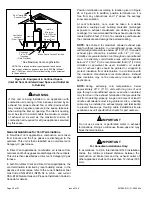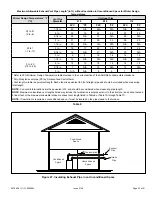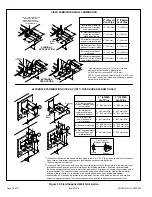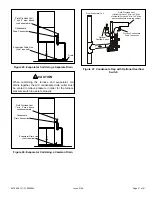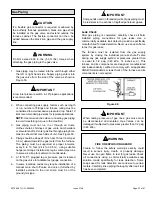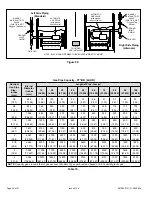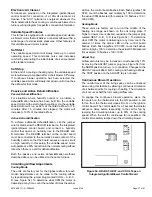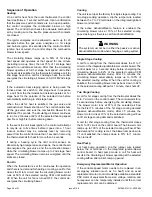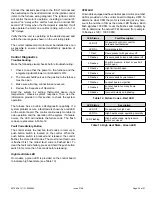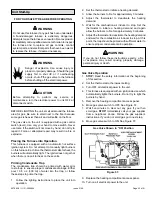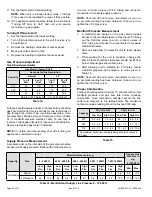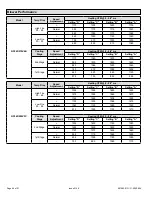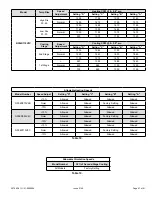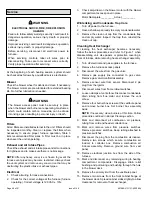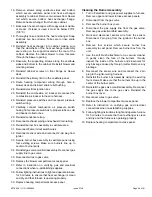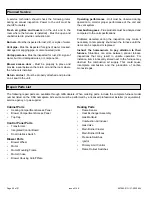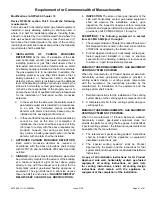
507962-01G / 31-5000654
Page 36 of 51
Issue 2149
Indoor Blower Speeds
1. When the thermostat is set to “FAN ON,” the indoor
blower will run continuously at approximately 50%
of the second stage cooling speed when there is no
cooling or heating demand. See Table 19 for allowable
continuous circulation speeds.
2. When this unit is running in the heating mode, the
indoor blower will run on the heating speed designated
by the positions of DIP switches 1 (A,B,C,D) of the
HEAT jumper plug. See Figure 54.
3. When there is a cooling demand, the indoor blower will
run on the cooling speed designated by the positions
of DIP switches (A, B, C, D) of the COOL jumper plug.
Generator Use - Voltage Requirements
The following requirements must be kept in mind when
specifying a generator for use with this equipment:
• The furnace requires 120 volts ± 10% (Range: 108
volts to 132 volts).
• The furnace operates at 60 Hz ± 5% (Range: 57 Hz
to 63 Hz).
• The furnace integrated control requires both polarity
and proper ground. Both polarity and proper grounding
should be checked before attempting to operate the
furnace on either permanent or temporary power.
• Generator should have a wave form distortion of less
than 5% THD (Total Harmonic Distortion).
Electrical Wiring
Risk of electrical shock. Disconnect electrical power
at the circuit breaker or service panel before making
electrical connections. Failure to disconnect power
supplies can result in property damage, personal injury,
or death.
WARNING
The furnace must be grounded and wired in accordance
with local codes or, in the absence of local codes, with the
National Electrical Code ANSI/NFPA No. 70 (latest edition)
and/or CSA C22.1 Electrical Code (latest edition) if an
external electrical source is utilized.
In all instances, other than wiring for the thermostat,
the wiring to be done and any replacement of wire shall
conform with the temperature limitation for Type T wire
–63°F (35°C) rise.
Connect a sufficiently sized wire with ground to the
furnace’s line voltage connections and ground wire. Refer
to the furnace rating plate for electrical characteristics
to be used in sizing field supply wiring and overcurrent
protection.
The line voltage supply should be routed through a readily
accessible disconnect located within sight of the furnace. A
junction box on the furnace side panel is provided for line
voltage connections. Refer to the furnace wiring diagram
for specific connection information.
Proper polarity of the supply connections (“HOT” and
“NEUTRAL”) must be observed to ensure that safety
controls provide the protection intended.
A connection to the unit’s ground wire and actual earth
ground (typically a ground stake or buried steel pipe) must
be maintained for proper operation.
Thermostat
Install a room thermostat according to the instructions
furnished with it. Select a location on an inside wall that
is not subject to drafts, direct sunshine, or other heat
sources. The initial heat anticipator setting should be equal
to the total current draw of the control circuit. Low voltage
thermostat connections are to be made to the integrated
ignition/blower control board as indicated on the wiring
diagram.
NOTE:
The automatic heat staging option allows a single
stage thermostat to be used with two stage furnace models.
To activate this option, move the jumper pin (see Figure 53)
to desired setting (5 minutes or 10 minutes). The furnace
will start on 1st stage heat and stay at 1st stage heat for
the duration of the selected time before switching to 2nd
stage heat. W1 on the control board must be connected to
W1 on the thermostat.
Figure 53. Automatic Heat Staging Jumper
Humidifier
Terminals are provided on the integrated ignition/blower
control board for connection to a 120-volt humidifier. The
“HUM” terminal is energized whenever the thermostat
calls for heat. See the furnace wiring diagram for specific
connection information.

